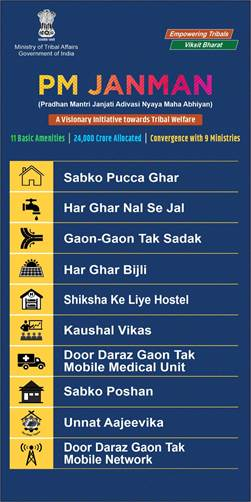First-ever Individual Entitlement Survey for PVTGs | 22 Nov 2025
Why in News?
The Centre is set to conduct the first-ever 'Individual Entitlement Survey' of 10 lakh Particularly Vulnerable Tribal Groups (PVTGs) households to assess the reach of 39 government schemes at the grassroots level.
What is an Individual Entitlement Survey?
- About: The Ministry of Tribal Affairs has identified 39 schemes across 18 central government departments for monitoring.
- These include the MGNREGS, social security for unorganised workers, pensions, financial assistance for meritorious Scheduled Tribe students, and various flagship programs.
- The survey will be conducted with the cooperation of state governments, which may involve NGOs or panchayat officials to help carry out the process.
- Scope and Coverage: The survey will cover 10 lakh households across 1,000 blocks, predominantly inhabited by approximately 48 lakh PVTGs.
- These groups are spread across 75 recognized PVTGs in 18 states and the Union Territory of Andaman and Nicobar.
- Methodology: Surveyors will input data directly into a mobile application developed by the National e-Governance Division (NeGD).
- Post survey completion, the government will issue a 'Universal Entitlement Card' to each tribal member from a vulnerable group, outlining their entitlement status for the tracked government schemes.
What is a Particularly Vulnerable Tribal Group (PVTG)?
- About: PVTGs is a sub-classification of Scheduled Tribes that are more vulnerable than regular Scheduled Tribes due to their limited access to education, healthcare, and modern infrastructure.
- These groups are often referred to as "primitive" because of their traditional lifestyles and limited exposure to modern amenities.
- Article 342(1) allows the President, after consulting the Governor (in the case of a state), to specify tribes or tribal communities as Scheduled Tribes in a State/UT.
- Identification Timeline: In 1973, the Dhebar Commission classified Primitive Tribal Groups (PTGs) as a distinct category for the least developed tribal groups, which were later renamed PVTGs by the Government of India in 2006.
- In 1975, India began identifying the most vulnerable tribal groups as PVTGs, initially declaring 52 groups, with an additional 23 added in 1993, bringing the total to 75 PVTGs out of 705 Scheduled Tribes.
- Classification Criteria: PVTGs are characterized by a small, homogenous population, physical isolation, lack of written language, simple technology, and slower social and economic development.
- They often face stagnant or declining populations, low literacy, and economic backwardness in remote areas with limited infrastructure and administrative support.
- Population: Odisha has the highest number of PVTGs (13), followed by Andhra Pradesh and Telangana (12).
What are Key India’s Initiatives Related to PVTGs?
- PM-JANMAN: PM JANMAN aims to protect and nurture tribal groups, especially those on the verge of extinction, by providing them with necessary support, development, and connectivity to mainstream services and opportunities.
- The initiative covers 75 PVTGs residing in 18 states and union territories, spread across 22,544 villages in 220 districts.

- Janjatiya Gaurav Divas: The Janjatiya Gaurav Divas is celebrated every year on the Birth Anniversary of Birsa Munda, to recognize the efforts of the tribals in the preservation of cultural heritage and promotion of Indian values of national pride, valour, and hospitality.
- These tribal communities include Tamars, Santhals, Khasis, Bhils, Mizos, and Kols to name a few.
- PM PVTG Mission: The PM-PVTG Development Mission program aims to improve the socio-economic status of Vulnerable Tribal Groups (PVTGs).
- The mission includes providing basic facilities like safe housing, clean drinking water and sanitation, education, health and nutrition, better access to roads in settlements for backward scheduled tribes.
Frequently Asked Questions(FAQs)
1. What is the purpose of the 'Individual Entitlement Survey'?
The survey aims to assess the reach of 39 government schemes and identify coverage gaps for 10 lakh PVTG households.
2. Which government schemes are being tracked in the survey? The survey tracks 39 schemes, including MGNREGS, social security for unorganised workers, and financial assistance for meritorious Scheduled Tribe students.
3. What is a Particularly Vulnerable Tribal Group (PVTG)?
PVTGs is a sub-classification of Scheduled Tribes that are more vulnerable than regular Scheduled Tribes due to their limited access to education, healthcare, and modern infrastructure.
UPSC Civil Services Examination, Previous Year Question (PYQ)
Prelims:
Q.1 Consider the following statements about Particularly Vulnerable Tribal Groups (PVTGs) in India: (2019)
- PVTGs reside in 18 States and one Union Territory.
- A stagnant or declining population is one of the criteria for determining PVTG status.
- There are 95 PVTGs officially notified in the country so far.
- Irular and Konda Reddi tribes are included in the list of PVTGs.
Which of the statements given above are correct?
- 1, 2 and 3
- 2, 3 and 4
- 1, 2 and 4
- 1, 3 and 4
Ans: (c)
Mains:
Q. What are the two major legal initiatives by the State since Independence addressing discrimination against Scheduled Tribes (STs)? (2017)
Q. Why are the tribals in India referred to as ‘the Scheduled Tribes’? Indicate the major provisions enshrined in the Constitution of India for their upliftment. (2016)
